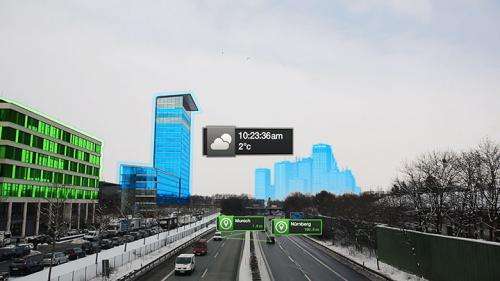(Phys.org)—Metaio this week announced its AREngine, an augmented reality chip that closes in on the future of smartphones as AR devices for daily use. The hardware chipset being introduced is a jump up for Metaio which has in the past focused on AR software. The AREngine is being promoted as a move to make "all-day AR possible" for mobile device users, a feature that will be easily appreciated by tourists, not to mention developers eager to gain from a riper ecosystem.
The company announced it has struck a deal with Geneva-based ST-Ericsson, which supplies wireless platforms and semiconductors to device makers. ST-Ericsson is to integrate the AREngine into ST-Ericsson mobile platforms.
What is referred to as Metaio's "proprietary hardware acceleration technology" will go into ST-Ericsson smartphone chipsets. The significance of the collaboration is that the processor is to be used specifically to accelerate and improve the performance of AR software on mobile devices.
According to ST-Ericsson, the hardware acceleration coming out of the Metaio pact will enable larger screen sizes, better resolution and better tracking accuracy yet "without the power-drain penalty associated with competing solutions."
According to the Metaio press release, the Metaio AREngine drastically reduces power consumption, which can make all-day AR experiences possible.
Metaio is not a newcomer; it was founded in 2003 in Munich, and has been working at AR advancements in software. The company co-founders are Thomas Alt, CEO, and CTO Peter Meier.
Regarding the new announcement, Meier said in a promotional video that ever since he joined the company, his goal has been "to provide a seamless AR experience that feels natural to the end user." This new piece of hardware being introduced, he added, is an augmented reality processing unit which will run and power the next generation of AR smartphones.
Meier said, "The AREngine will do for Augmented Reality what the GPU did years ago for the gaming industry." Translation: a great leap forward.
A spokesperson from ST-Ericsson said its link with Metaio is not only as a business partner but the two are also joint participants in the European collaborative research project, Venturi. Targeting "the shortcomings of current Augmented Reality design," the project is defined as all about bringing together the forces of mobile platform manufacturers, technology providers, content creators, and researchers in the field. Venturi's goal is to create "a pervasive AR paradigm, where available information will be presented in a 'user' rather than a 'device' centric way."
More information:
— www.metaio.com/press/press-rel … re-mobile-platforms/
— venturi.fbk.eu/
© 2013 Phys.org























